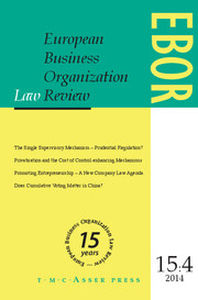Article contents
Recharacterization and the Nonhindrance of Creditors
Published online by Cambridge University Press: 21 June 2006
Abstract
Using a 1977 article by Robert Clark as the starting point, this article attempts to shed new light on the question of whether and when shareholder loans to her company should be either equitably subordinated or, as courts have done in a few recent cases, recharacterized as equity. In its emphasis on the particular issue of shareholder loans, the article has a narrower compass than Clark’s article, which uses a four-part typology to explore the relationship among fraudulent conveyance law, equitable subordination, veil piercing and dividend restrictions. But the article also expands Clark's analysis in several respects. The most important adjustment involves the general Nonhindrance ideal, which we use to identify a crucially important form of interference with the rights of creditors that Clark does not himself consider directly.
Part 1 of the article very briefly describes the 1939 Supreme Court case that served as a well-spring for equitable subordination doctrine in general, and for subordination of shareholder loans in particular. Part 2 then focuses on a series of recent decisions that have wrestled with the question whether shareholder loans should be recharacterized as equity contributions. Recharacterization doctrine is closely related to equitable subordination, but most courts view it as a separate development. Part 2 suggests that much of the confusion in the cases could be eliminated by disentangling two issues, whether the status of a loan is ambiguous (which raises issues of Truth, in terms of Clark's typology) and whether it was likely to destroy value that would otherwise go to creditors (the Nonhindrance concern); and by distinguishing bankruptcy recharacterization from the tax characterization cases that seem to have spawned the new doctrine. Part 3 then concludes by briefly considering the German and Austrian approaches to these same issues, which focus on capitalization and creditworthiness.
The most important, and initially counterintuitive, implication comes in Part 2: whereas US courts have treated security interests as a badge of legitimacy in assessing shareholder loans, secured loans are actually the most worrisome form of shareholder investment. These security interests, we argue, should be disallowed.
Keywords
- Type
- Articles
- Information
- Copyright
- T.M.C. Asser Press 2006
- 8
- Cited by


